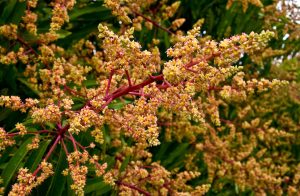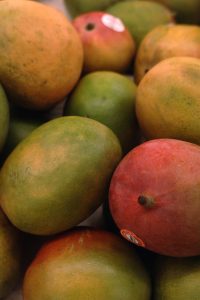
Mango season is here. Mango trees on home landscapes and orchards in South Florida are working their way through the fruiting stage, making it prime time as the tiny flowers have begun to reveal tiny fruit.
The 2023 mango season erupted with an abundance of fruit last year. Will that be the case for 2024? What can researchers tell mango devotees as the early signs of fruiting begin to show?
It is a busy time for two experts at the University of Florida Institute of Food and Agricultural Sciences (UF/IFAS) in Homestead as they begin to see what orchards and home landscapes are revealing in South Florida.
Meet Jeff Wasielewski, a commercial tropical fruit crops agent at UF/IFAS Extension Miami-Dade County, and Jonathan Crane, a UF/IFAS professor, tropical fruit crop specialist and associate center director at UF/IFAS Tropical Research and Education Center (TREC). Together they are taking questions from consumers and growers, visiting orchards, hosting workshops and conducting research on Florida’s more than 200 mango varieties.
Here is a peak at what they are seeing, what growers are saying and the latest research at the TREC labs that is keeping mangos in the minds of consumers from South Florida where the fruit is king.
Jeff Wasielewski:

Q: What are common questions you are receiving this year so far?
A: General questions like, “What are these spots on my leaves?” These can be attributed to a fungus know as anthracnose that attacks flowers, young fruits, leaves and twigs. Another question, I often received is, “Why isn’t my tree fruiting?” There are many reasons a tree isn’t fruiting including too shaded, pruned too aggressively, over watered, over fertilized, heavy pest damage, or it’s just a bad year.
Q: Have any changes taken place since last year that might indicate a potential change in this year’s yields?
A: This year we had two big blooms, an early one and a late one during the season. Unfortunately, we had a lot of rain after each bloom and that knocked off blossoms and set the stage for anthracnose potentially killing off some of the young fruit. Things are not looking great as far as fruit set this year as they did last year. The good news is that we should still get some fruit this year, and we can certainly dream of a bumper crop for next year.
Q: Are there any new practices homeowners should be applying to benefit next year’s yield?
A: It’s always a good idea to keep your trees pruned to let in air and light. This helps with keeping disease down. If you are looking to acquire a tree, choosing the right location to plant your tree and choosing cultivars that are less disease prone is another tip. There are cultivar recommendations and a list of where to buy fruit trees online. Some cultivars you may want to consider are Fairchild, Rosigold, Glenn, Angie and Orange Sherbet.
Q: What should homeowners be paying attention to this year that may tell them their mango tree may yield differently this year?
A: It’s all in the fruit. It is as simple as looking up at the trees and seeing what held on. Fruit should be about the size of an old school silver dollar or slightly bigger right now. There may still be some fruit drop, but what held on so far is in good shape.
Q: Does pruning a mango tree assist or hinder yield at certain seasons?
A: If you prune too late in the season or too severe, you will disrupt the blooming cycle. Too late, like October or later, or pruning more than 35% of the canopy will cause the tree to put out vegetative growth and not focus on blooming.
Q: When is the best time to prune a mango tree?
A: Prune after you pick the last fruit. You are pruning to open up the tree and keep the height down to less than 15 feet. If you have a small tree, you can give it a shot. If it is large, make sure to hire a certified arborist.
Jonathan Crane:
Q: What are growers saying about their orchards so far?
A: In general, the mango fruit set is down this year and varies from slightly lower than last year to a good year to even a disastrous year. Some growers attribute their lack of yield to the weather during the bloom period, such as unseasonal rainfall and/or wind, others blame the intensity of pests and diseases attacking the bloom and flowers.
Q: Are there any new varieties that growers are trying out, and what are some interesting characteristics consumers can look out for at the supermarket?
A: There is a whole host of older unique varieties and new varieties being grown, with many of the new varieties selected in the private breeding program of Zill High Performance Plants. Most of these will be found through direct market outlets and online.
Q: What can we expect to see from Florida’s mango market?
A: A large diversity of Florida-grown mango varieties in specialty markets online and through direct marketing. Florida’s strength is growing unique, high quality, mango varieties that are not found in the major mango trade – these mango varieties are for mango afficionados who appreciate the different aromas, flavors, shapes, textures, and colors of mango.
Q: What research is taking place at TREC and why?
A: Very little is known about the metabolism involved in the aroma and flavor we all love about mangos. The storage characteristics of many varieties is unknown, and while few varieties have been consumer tested, the stages of plant growth such as when they flower, flush, go dormant and are harvested of many varieties is not well documented.
A team of UF scientists just completed a project investigating the metabolomics of mango aroma and flavor (Dr. Yu Wang, Citrus Research and Education Center), postharvest handling (Dr. Jeff Brecht, horticultural sciences), consumer evaluations and acceptance (Dr. Charles Sims, food science and human nutrition), and phenology (tree growth phases) (Dr. Jonathan Crane, TREC). All this was an effort to link the metabolomics, postharvest handling, consumer acceptance and phenology for future mango breeding and selection programs.
Q: What are three factoids about Florida mangoes that new growers should know?
A: With proper orchard site selection, careful selection of which varieties to grow, and dedication to various marketing tactics, mango production in Florida can be profitable.
###
By Lourdes Mederos, rodriguezl@ufl.edu
Para accesar a este contenido en español, por favor utilice este enlace.
ABOUT UF/IFAS
The mission of the University of Florida Institute of Food and Agricultural Sciences (UF/IFAS) is to develop knowledge relevant to agricultural, human and natural resources and to make that knowledge available to sustain and enhance the quality of human life. With more than a dozen research facilities, 67 county Extension offices, and award-winning students and faculty in the UF College of Agricultural and Life Sciences, UF/IFAS brings science-based solutions to the state’s agricultural and natural resources industries, and all Florida residents.
WHY FOOD IS OUR MIDDLE NAME
Feeding a hungry world takes effort. Nearly everything we do comes back to food: from growing it and getting it to consumers, to conserving natural resources and supporting agricultural efforts. Explore all the reasons why at ifas.ufl.edu/food or follow #FoodIsOurMiddleName.
 2
2
